Abstract
Asset management is not new, and research has been conducted in private and public sectors on how to systematically maintain infrastructure or facilities for sustainable use and achieve the level of service desired by users or customers at the lowest life cycle costs. This research identifies the research topics and trends in asset management over the past 30 years. To this end, latent Dirichlet allocation, a topic modeling approach, was applied to articles published in engineering journals and investigated the following three research questions: (1) what have the key topics been for the past three decades? (2) what are the main activities and target sectors of asset management? (3) how have the research topics and keywords changed over the past three decades? The analysis shows that the target field of asset management has broadened while the main activities of asset management have been limited to several popular activities such as life cycle cost analysis and reliability analysis. Some implications and future research directions are also discussed.
1. Introduction
Since the release of the International Organization for Standardization (ISO) 55000 standard series in 2014 [1], an increasing number of companies have been interested in asset management. Assets are items or articles that have potential or actual value to an organization and are generally physical or material since asset repair and maintenance are the main topics of asset management. The scope of asset management can vary, but according to the Institute of Asset Management (IAM) and ISO 55000, it includes strategic planning for asset management, asset management decisions, asset lifecycle management, and asset information system construction and operations [2]. Asset management is not new, and research has been conducted in private and public sectors on how to systematically maintain infrastructure or facilities and achieve the level of service desired by users or customers at the lowest life cycle costs. The concept of asset management, which had been focused on maintenance at first, expanded over time to include the strategic decision making of the entire organization.
The conceptual asset management model proposed by the IAM is shown in Figure 1.
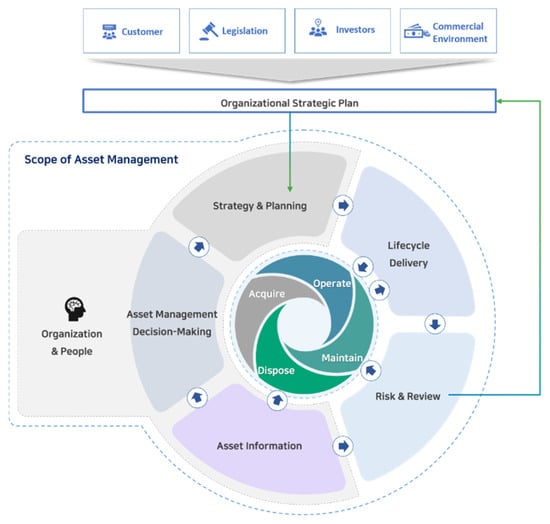
Figure 1.
Conceptual asset management model.
In Figure 1, an organization’s strategic planning includes the establishment of an asset management policy, which provides the basic system for converting the organization’s strategic goals into asset management goals and the principles that drive the development of the asset management strategy. Next, asset management decision making refers to the various decisions related to assets in the organization, such as capital investment decision making, operation and maintenance decision making, asset life cycle decision making, resource acquisition and procurement decision making, facility stoppage decisions, and decision making related to downtime.
In addition, lifecycle management manages the entire lifecycle of assets, from the creation and acquisition of assets to their operations, maintenance, and disposal, and it can be viewed as a key area of asset management from a practical point of view [3,4,5]. In fact, numerous studies related to maintenance and reliability have been conducted in various industries, and most studies have been related to asset management decisions or life cycle management.
The construction and operations of the asset information system is related to asset information, which is becoming increasingly important [6,7,8]. The timely collection and systematic management of asset information are very important for asset management decision making and life cycle management. In addition, it is also necessary to establish an asset information standard [9,10], and it is necessary to clearly define what information is collected and managed. The collected asset information should be recorded and managed in an asset information system, and the asset information system should be utilized in connection with the existing information system used by the company. The accuracy of asset information is related to the accuracy of asset management decision making and lifecycle management, and its importance is increasing [11,12].
Asset management itself benefits an organization in many ways. It is possible to make investment decisions based on accurate information and achieve financial gains due to the increased asset life [13,14]. In addition, it is possible to identify and respond to expected risks related to assets in advance, thereby increasing the safety level of the workplace [15]. In addition, successful asset management increases a company’s reputation and consequently improves the company’s sustainability.
Another reason why asset management has attracted attention is that because of the development of information and communication technology (ICT), more systematic and improved asset management is possible [16,17]. Typically, the development of sensors [18] and big data processing technology collected from sensors and machine learning technology to analyze collected big data [19] can greatly increase the competitiveness of asset management.
As mentioned above, this study examines the trend of the related research on asset management, which has become increasingly important over the past 30 years. Thus, this study examines how the research on asset management has broadened its scope and target sectors. By examining past studies centered on the topic, we determine the industries that have been focused on changing the interests of related researchers and asset management.
Additionally, based on the analyzed research trend of asset management, we investigate the following research questions:
- RQ1: What have been the key topics for past three decades?
- RQ2: What are the main activities and target sectors of asset management?
- RQ3: How have the research topics and keywords changed over the past three decades?
To this end, this study uses topic modeling, a representative text mining methodology. Scientific publication is often considered a key proxy to reflect the trend of the research development in both theory and practice [20]. Some researchers investigated the article meta data (i.e., title, abstract, keywords, etc.) related to various research fields such as operations research, transportation, etc. [21,22,23,24]. Among the article meta data, the title and the keywords of an article are the core pieces of content-related information in terms of the individual words we can investigate since they are solely and carefully selected by the authors who know the main contributions of an article. Of course, the abstract can be considered a condensed representation of an article, but it might contain descriptions of the backgrounds and motivations of the researchers that are not directly related to their output or contribution, which lead to misunderstanding what the authors want to emphasize from their research.
Thus, this study investigates the research trends and topics using the titles and keywords obtained from related research conducted between 1991 and 2019. To the best of our knowledge, there is a lack of research that has applied topic modeling to the field of asset management to identify the trends and topics. The main contributions of this research are to answer the abovementioned research questions and to provide research directions to researchers and practitioners. Also, this research might stimulate further discussion on the necessity of asset management research among the related experts.
The remainder of this paper is organized as follows. The main methodology and topic modeling are explained in Section 2. The model design for applying topic modeling to the collected data is presented in Section 3. The results and analysis with implications are summarized in Section 4. Finally, Section 5 provides some concluding remarks and directions for future research.
2. Methodology
To answer the research questions, a mixed method called computational content analysis, which combines text mining and content analysis, was used. In particular, a text summarization technique called latent Dirichlet allocation (LDA) and expert-driven content analysis were applied to bibliographic data on physical asset management. First, LDA with collapsed Gibbs sampling was conducted. Also, the optimal number of topics based on a perplexity measure was set, and the results were visualized using LDAvis, which is a helpful visualization tool for LDA results. Then, based on LDA results, the main topics were identified. Then, the meanings and relationships of the topics and their corresponding words were induced to answer our research questions. In short, the research questions were examined using computational content analysis.
2.1. Latent Dirichlet Allocation
LDA applies Bayesian learning to a hierarchical probability distribution that is layered by a probability distribution over topics and a probability distribution of each topic over words [25]. LDA begins with random probability distributions but fits the distributions to given data. It observes the words in each document and updates the topic probability distributions over words conditioned on the observed words. Accordingly, it finds the probability distribution of each document over topics, the probability distribution of each topic over words, and the topic assignment for each word when the words in each document are fed. Namely, LDA generates , where is a topic probability distribution of document and is controlled by parameter , is a word probability distribution of topic generated by parameter , is a topic assigned to the word in document d, and is the word observed in document as shown in Figure 2. This is the posterior probability distribution, which is a multinomial distribution; and it can be computed by the following equation:
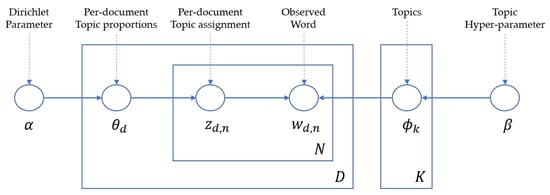
Figure 2.
LDA illustration.
The numerator can be rewritten as the following equation:
This equation is a joint distribution of all the random variables, which can be easily computed. The first two terms represent the prior probability. The latter is a model. The observable variable is , which can be drawn from documents. LDA uses Dirichlet-multinomial conjugate relationships. is a Dirichlet distribution conditioned on parameter . is a Dirichlet distribution conditioned on parameter .
The denominator is difficult to calculate exactly because the marginal is intractable. In theory, it can be computed by summing the joint distribution over every possible instantiation of the hidden topic structure. However, the number of possible topic structures is exponentially large; and thus, this sum is intractable to compute.
Possible computational solutions to approximately compute the denominator are collapsed Gibbs sampling, where and are marginalized out, and only the latent variable is sampled. After the sampler has been burned in, the estimates of and given can be calculated.
Thus, the collapsed Gibbs sampling for LDA needs to compute the probability of topic being assigned to word , given all other topic assignments to all other words. More formally, what needs to be computed is the following posterior:
where represents that the probability that topic is assigned to word is ‘’, and implies all topic allocations except for . By applying some rules of conditional probability, the following equation can be obtained [26,27]:
where is the number of times topic appears in document , is the number of times word appears in topic , , and are hyperparameters related to the Dirichlet distribution, is the number of topics, and is the number of words in the corpus.
Using the above equation, the collapsed Gibbs sampling can be conducted as follows:
- (1)
- Assign any topic to each word randomly.
- (2)
- From the first word () of the first document (), the following actions can be conducted:
- (3)
- Calculate by changing topics (i.e., ), and choose one of topics considering the calculated .
- (4)
- Repeat Step (3) until the last word () of the last document () is reached.
- (5)
- Repeat Steps (2)–(4) until the assignment of topics for each word is stabilized.
2.2. Determining the Number of Topics Using Perplexity
LDA is an archetypal statistical model for discovering topics in a collection of documents. LDA learns latent variables made of mixtures of words in documents. The latent variables are called topics because they can be interpreted as subjects that comprise the collection of documents. is fixed before applying LDA to the collection of documents, which makes it difficult to define its optimality. One way to check if the fixed is an optimal number is using the concept of perplexity [28]. Perplexity is the degree of ambiguity a prediction has in information theory. Namely, if a probability distribution or a probability model makes a good prediction, the loss of information to represent subjects is low, which means that the prediction is certain. The lower the perplexity score is, the better the representation of subjects. The perplexity score can be computed as the inverse of the geometric mean per-word likelihood. It is an exponential function whose exponent is the log likelihood per word if is the word, as shown in Equation (5). Scikit-Learn was used for the implementation of perplexity, where is Euler’s number, . In general, the optimal is the minimum among the perplexity scores for different numbers of topics.
2.3. Latent Dirichlet Allocation Visualization
LDAvis is a tool to help users interpret topics using data visualization [29]. It allows people to easily examine a ranked list of the most relevant terms in each topic. The authors provide a user-controlled variable called relevance. Relevance measures the degree to which a word appears in a certain topic to the exclusion of others according to the user’s input, and it ranges from 0 to 1. The relevance of word w to topic k is determined by a weight parameter, . Setting results in the familiar ranking of terms in decreasing order of their topic-specific probability and setting ranks terms solely by their lift [29]. It is the weighted sum of the previous two when is between 0 and 1. A topic-specific probability is explained by the concept of the saliency of a word, as in [30]. Saliency acts as an indicator to order the most important terms of each topic.
The outcome of LDAvis contains two parts: (1) the left part for the two-dimensional space of the principal components, and (2) the right part for the top 30 terms of each selected topic. In the two-dimensional space, every topic is expressed as a circle, and the location of each circle represents the relative position of the topic considering the relevance and saliency of words. The size of a circle represents the relative proportions of the topic among all the topics.
In the right part of the outcome of LDAvis, when clicking the circle (i.e., selecting any topic) in the left part for the two-dimensional space, 30 red bars that show the term frequency of each of the top 30 terms appear. Along with the red bars, blue bars representing the overall term frequency of each term are also provided. In short, when a topic is selected, 30 red bars and blue bars appear. Thus, the interpretation of the words with the estimated frequency of each topic and the comparisons with other topics in the two-dimensional space of principal components help us identify the subject of each topic.
An illustrative figure of LDAvis is presented in the following section.
3. Experimental Design
In this study, an academic search engine, Scopus, was used to obtain a set of documents required for modeling. Among the papers written from 1991 to 2019, a total of 2276 articles mentioned “asset management” in the title, keyword, and abstract in the engineering journal category. Topic modeling was conducted by treating the title, author keyword, and index keyword of each paper as a single instance.
Among the article metadata, the title and the keywords of an article are the core pieces of content-related information in terms of the individual words we investigate since they are solely and carefully selected by the authors who know the main contributions of an article. Of course, the abstract can be considered a condensed representation of an article, but it might contain descriptions of the backgrounds and motivations of the research that are not directly related to their output or contribution.
In addition, to determine the number of topics, , we calculated the perplexity scores of our collected document set, as explained in Section 2.2. By calculating the perplexity scores by changing from 1 topic to 30 topics for the collected document set, the number of topics was found with one of the lower perplexity scores, which shows a sudden change in scores from high to low. Figure 3 shows the calculated perplexity scores in this research. As shown in Figure 3, the number of topics was determined to be 12, and this number was used for further analysis.
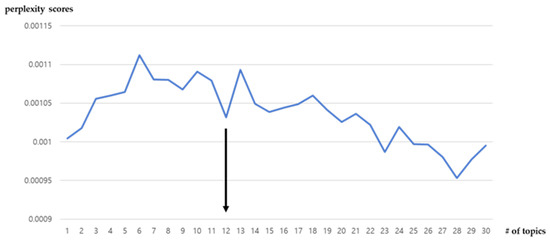
Figure 3.
Perplexity scores.
4. Analysis
By fixing the number of topics to 12, LDA analysis was performed to extract topics, and visual data, as shown in Figure 3, could be obtained. All experiments were conducted by running Python with the required packages, such as pyLDAvis 2.1.2, gensim 3.8.1, wordcloud 1.6.0, matplotlib 3.1.1, etc.
Additionally, collapsed Gibbs sampling was used for inference, and the hyperparameters and were set to 0.3 and 0.01, respectively. To determine these hyperparameters, we conducted pre-experiments that changed them. In general, higher values for the hyperparameters tend to smooth the distribution of the given words or topics while lower values for them would emphasize the unique proportion of any words or topics. This is because the hyperparameters are added to both the denominator and numerator in the collapsed Gibbs sampling, as represented in Equation (4). Thus, if any large value for and/or is added, the effects of and/or could be diluted. Due to the difference between the number of topics and the number of words ( and , respectively), for the corresponding (limited by the number of words) is set to be much lower than for the corresponding (limited by the number of topics).
4.1. Identifying the Key Topics (RQ1)
As mentioned at the beginning of Section 2, identifying the subject of each topic group using the outcome of the LDA is needed. To do this, not only the term frequency within the selected topic group but also the overall term frequency should be checked. As explained in Section 2.3, two different bars exist in the right part of LDAvis: the red bar representing the term frequency within the selected topic and the blue bar representing the overall term frequency. Of course, it should pay more attention to the terms at the top of the list, but it also needs to check the difference between the length of the red bar and the length of the blue bar. If the length difference between two bars is small, this means that this term is mainly found only in this topic. Thus, such words should be used to identify the main subject of that topic.
Figure 4 shows an explanatory figure of the LDAvis outcome for Topic 1.
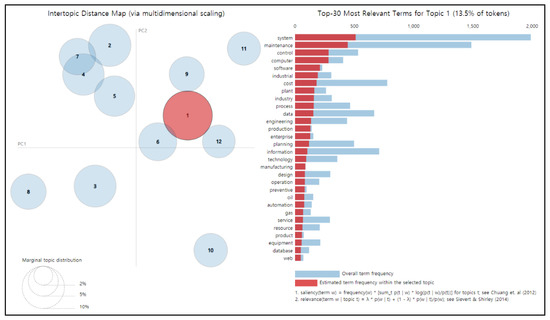
Figure 4.
An explanatory figure of LDAvis outcome (Topic 1).
For example, in Figure 4, ‘software’ is the fifth term of the list in the right part of the LDAvis, and the difference in the length between the related red and blue bars is very small. This shows that ‘software’ seems to be important in this topic. Using this type of content analysis, the subject of Topic 1 was determined to be system maintenance using computer software. Additionally, similar analysis and naming for the remaining 11 topics were conducted.
Table 1 shows the terms related to each topic derived through LDA.

Table 1.
Main terms of the 12 topics from LDA.
4.2. Investigating the Main Activities and Target Sector of Asset Management (RQ2)
As shown in Table 1, Topic 1 (system maintenance) seems to be a core theme of overall physical asset management, which contains the main objective: system maintenance. Additionally, topics 3 (monitoring), 4 (decision making), 7 (life cycle and cost analysis), 8 (reliability analysis), 10 (partial discharge), and 11 (information modeling) can be considered as the six main activities in system maintenance. However, some of them might focus on specific application areas such as electric power (Topic 3), bridges (Topic 7), electric cables (Topic 10) and buildings (Topic 11). In particular, Topic 10 is related to a very specific and limited subject that might not be generalized to other industries.
Last, the rest of the topics are related to the target domain, which requires physical asset management. Representatively, the transportation infrastructure (Topic 2), water system (Topic 5), energy industry (Topic 6), railroad network (Topic 9), and communication system (Topic 12) are the main target domains, and all of them are infrastructure.
Table 2 summarizes the categories of the 12 topics.

Table 2.
Classification of the 12 topics.
Table 2 shows that all the topics regarding asset management can be classified into two parts of activity and application area under an ultimate goal: system maintenance.
Although many studies have been performed on the above 12 issues, there is still a lack of research. First, the application areas are limited to infrastructure such as highways, roads, water systems, bridges, and buildings. In addition to infrastructure, mechanical installations or equipment can be the target of physical asset management. Many equipment such as turbines and motors need to be checked periodically to prevent failure. Next, research on the condition or health index monitoring of assets seems to be missing, although Topic 3 covers transformer monitoring. In general, monitoring can be considered as the first step of system maintenance because any maintenance decision can be made according to the condition of an asset.
4.3. Trends in the Research Topics and Keywords over the Past Three Decades (RQ3)
Figure 5 shows the number of articles for each topic from 1991 to 2019 and the total number of articles for that year. In 2007, the amount of research on asset management increased rapidly, and the figure shows that this research has been steadily increasing since 2011.
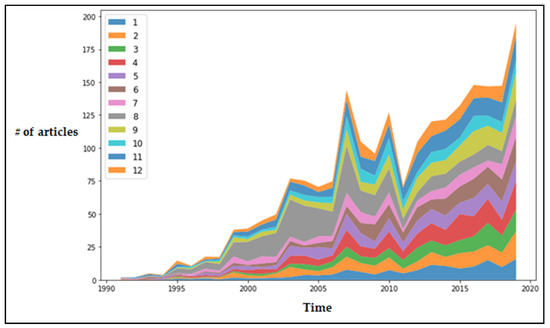
Figure 5.
Number of articles on each topic from 1991 to 2019.
In Figure 5, the number of related papers suddenly decreased in 2011. This seems to an effect of the aftermath of the global financial crisis at the end of 2000. To check this inference, the articles that contained ‘maintenance’ in the search field of titles, keywords, and abstracts were searched from Scopus and it can be found that there existed a similar trend, as shown in Figure 6. Due to the impact of the global financial crisis, most firms sought to limit their costs as much as possible, and this might have led to a decrease in interest in asset management. Considering its own nature, asset management can be seen as a conservative technique, which means that firms are not willing to invest aggressively in comparison with other management techniques such as R&D or marketing. Therefore, the related research, which usually needs real data or cases, could be reduced.
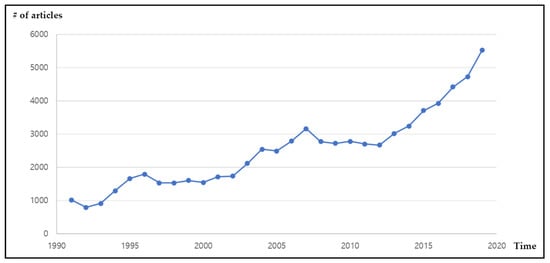
Figure 6.
Number of ‘maintenance’ related articles from 1991 to 2019.
Figure 7 is a graph showing how the weight of topics in each year change. Figure 5 and Figure 7 confirmed that the amount of research on asset management is increasing for all topics, but there is a difference in the amount of the increase.
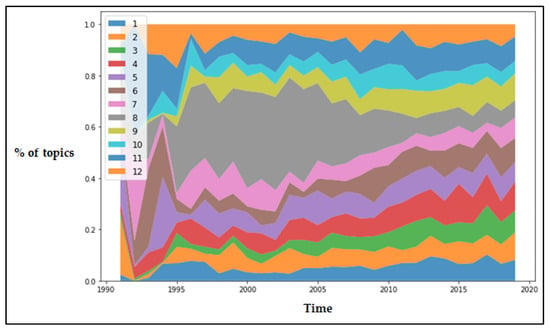
Figure 7.
Ratio of articles on each topic from 1991 to 2019.
Before 2010, research on Topic 8 (reliability analysis for maintenance) occupied a large proportion, but after 2010, all topics were studied relatively evenly.
To check the trend using the representative keyword of each year, a word cloud was created with words included in each year’s articles, and it visualized what words were used in the articles of that year, as shown in Figure 8.
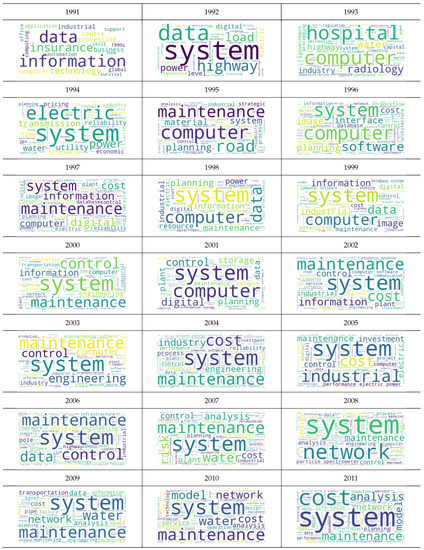

Figure 8.
Word clouds of each year’s articles from 1991 to 2019.
The size of each word is the percentage of its inclusion in all articles that year. Through this table, it can be checked which studies were mainly conducted each year and the key keywords. From 1991 to 2019, it can be clearly seen that the most important keywords in asset management are system and maintenance, that is, Topic 1 from the LDA analysis. Since the late 1990s, these words have consistently appeared in large proportions. Until the early 2000s, words such as ‘information’, ‘computer’, and ‘data’ were noticeable. In these periods, it can be inferred that researchers studied asset management using computer-based information systems. Additionally, in the 1990s, it seems that the target fields of asset management were ‘highway’, ‘hospital’, and ‘road’. However, since the late 2000s, ‘water’ and ‘transportation’ have continuously occurred. In particular, the term ‘infrastructure’ can be found easily since 2012, and it has been recognized as one of the key terms until now. In short, in the early ages of this research, researchers might have had an interest in an independent target such as roads, highways, and hospitals. However, in the 2000s, the trend changed from individual targets to aggregated assets such as transportation and broadened to water systems. More recently, ‘decision making’, ‘analysis’ and ‘model’ are more popular.
5. Conclusions
As infrastructure safety has become one of the most important issues in society and because strategic asset management directly affects the competitiveness of firms, interest in asset management is gradually increasing. In line with this trend, international standards such as the ISO 55,000 series and various related manuals are being published.
This study performed analysis of the past 30 years of research related to asset management using topic modeling. As a result of the analysis, 12 latent topics were found. In particular, life cycle cost analysis, reliability analysis, and decision making have been investigated mainly for infrastructure under the goal of system maintenance.
In the early days of the past research, there were many studies on reliability analysis regarding asset management, but the research topics related to asset management diversified over time. Additionally, the past focus was mainly on individual assets, but increasingly, the term social infrastructure has been used, and the focus has been on asset collection.
As a limitation of this study, the relevant research conducted in the social science field was not included by searching only the articles published in engineering journals. In addition, it is difficult to argue that all the collected articles were completely analyzed because topic modeling was performed only on the titles and keywords of articles instead of the full text content.
For future research, it is necessary to classify existing articles by asset class (e.g., equipment, infrastructure, facility, etc.) and to examine more specific research trends for each asset class. In addition, it is necessary to investigate the research trend regarding how 4th Industrial Revolution technologies such as big data analysis and artificial intelligence are connected to asset management because these technologies are regarded as better means for monitoring and collecting condition information on physical assets. The reason why those recent technologies did not appear as topics in this research is probably because this study extracted the most important latent topics from the related articles of the past three decades. However, since those technologies are attracting more and more attention from the researchers, they might appear more often in research articles in the near future.
Author Contributions
H.J. and B.K. conceived and designed this research and experiments; B.K. collected the required data and conducted the experiments using Python; H.J. analyzed the data and wrote the paper. All authors have read and agreed to the published version of the manuscript.
Funding
This work was supported by INHA UNIVERSITY Research Grant (61639-01).
Institutional Review Board Statement
Not applicable.
Informed Consent Statement
Not applicable.
Data Availability Statement
The raw data can be retrieved from Scopus DB.
Conflicts of Interest
The authors declare no conflict of interest.
References
- IAM. Available online: https://theiam.org/ (accessed on 29 March 2021).
- ISO. Available online: https://www.iso.org/standard/55088.html (accessed on 29 March 2021).
- Schuman, C.A.; Brent, A.C. Asset life cycle management: Towards improving physical asset performance in the process industry. Int. J. Oper. Prod. Manag. 2005, 25, 566–579. [Google Scholar] [CrossRef]
- Amadi-Echendu, J.E.; Willett, R.J.; Brown, K.A.; Lee, J.; Mathew, J.; Vyas, N.; Yang, B.-S. What is engineering asset management? In Proceedings of the 2nd World Congress on Engineering Asset Management and the 4th International Conference on Condition Monitoring, Harrogate, UK, 11–14 June 2007. [Google Scholar]
- Roda, I.; Macchi, M. Studying the funding principles for integrating Asset Management in Operations: An empirical research in production companies. In Proceedings of the 3rd IFAC Workshop on Advanced Maintenance Engineering, Services and Technology AMEST 2016, Biarritz, France, 19–21 October 2016. [Google Scholar]
- Hipkin, I. Knowledge and IS implementation: Case studies in physical asset management. Int. J. Oper. Prod. Manag. 2001, 21, 1358–1380. [Google Scholar] [CrossRef]
- Faiz, R.B.; Edirisinghe, E.A. Decision making for predictive maintenance in asset information management. Interdiscip. J. Inf. Knowl. Manag. 2009, 4, 23–36. [Google Scholar]
- Ouertani, M.Z.; Parlikad, A.K.; McFarlane, D.C. Towards an approach to Select an Asset Information Management Strategy. IJCSA 2008, 5, 25–44. [Google Scholar]
- Braaksma, A.J.; Klingenberg, W.W.; van Exel, P.P. A review of the use of asset information standards for collaboration in the process industry. Comput. Ind. 2011, 62, 337–350. [Google Scholar] [CrossRef]
- Koronios, A.; Nastasie, D.; Chanana, V.; Haider, A. Integration through standards–an overview of international standards for engineering asset management. In Proceedings of the Fourth International Conference on Condition Monitoring, Harrogate, UK, 11–14 June 2007. [Google Scholar]
- Lin, S.; Gao, J.; Koronios, A.; Chanana, V. Developing a data quality framework for asset management in engineering organisations. Int. J. Inf. Qual. 2007, 1, 100–126. [Google Scholar] [CrossRef]
- Sherwin, D. A review of overall models for maintenance management. J. Qual. Maint. Eng. 2000, 6, 138–164. [Google Scholar] [CrossRef]
- Tam, A.S.; Price, J.W. A generic asset management framework for optimising maintenance investment decision. Prod. Plan. Control 2008, 19, 287–300. [Google Scholar] [CrossRef]
- Vanier, D.D. Why industry needs asset management tools. J. Comput. Civ. Eng. 2001, 15, 35–43. [Google Scholar] [CrossRef]
- Abu-Siada, A.; Islam, S. A new approach to identify power transformer criticality and asset management decision based on dissolved gas-in-oil analysis. IEEE Trans. Dielectr. Electr. Insul. 2012, 19, 1007–1012. [Google Scholar] [CrossRef]
- Haider, A.; Koronios, A. ICT based asset management framework. In Proceedings of the Seventh International Conference on Enterprise Information Systems, Miami, FL, USA, 25–28 May 2005; pp. 312–322. [Google Scholar]
- Kivits, R.A.; Furneaux, C. BIM: Enabling sustainability and asset management through knowledge management. Sci. World J. 2013, 2013, 983721. [Google Scholar] [CrossRef] [PubMed]
- Abu-Elanien, A.E.; Salama, M.M.A. Asset management techniques for transformers. Electr. Power Syst. Res. 2010, 80, 456–464. [Google Scholar] [CrossRef]
- Campos, J.; Sharma, P.; Gabiria, U.G.; Jantunen, E.; Baglee, D. A big data analytical architecture for the Asset Management. Procedia CIRP 2017, 64, 369–374. [Google Scholar] [CrossRef]
- Sun, L.; Yin, Y. Discovering themes and trends in transportation research using topic modeling. Transp. Res. Part C Emerg. Technol. 2017, 77, 49–66. [Google Scholar] [CrossRef]
- Kim, W.; Khan, G.F.; Wood, J.; Mahmood, M.T. Employee engagement for sustainable organizations: Keyword analysis using social network analysis and burst detection approach. Sustainability 2016, 8, 631. [Google Scholar] [CrossRef]
- Zheng, B.; McLean, D.C.; Lu, X. Identifying biological concepts from a protein-related corpus with a probabilistic topic model. BMC Bioinform. 2006, 7, 1–10. [Google Scholar] [CrossRef] [PubMed]
- De Battisti, F.; Ferrara, A.; Salini, S. A decade of research in statistics: A topic model approach. Scientometrics 2015, 103, 413–433. [Google Scholar] [CrossRef]
- Wang, L.; Xue, X.; Zhao, Z.; Wang, Z. The impacts of transportation infrastructure on sustainable development: Emerging trends and challenges. Int. J. Environ. Res. Public Health 2018, 15, 1172. [Google Scholar] [CrossRef] [PubMed]
- Blei, D. Probabilistic topic models. Commun. ACM 2012, 55, 77–84. [Google Scholar] [CrossRef]
- Porteous, I.; Newman, D.; Ihler, A.; Asuncion, A.; Smyth, P.; Welling, M. Fast collapsed gibbs sampling for latent dirichlet allocation. In Proceedings of the 14th ACM SIGKDD International Conference on Knowledge Discovery and Data Mining, Las Vegas, NV, USA, 24–27 August 2008; pp. 569–577. [Google Scholar]
- Darling, W.M. A theoretical and practical implementation tutorial on topic modeling and gibbs sampling. In Proceedings of the 49th Annual Meeting of the Association for Computational Linguistics: Human Language Technologies, Portland, OR, USA, 19–24 June 2011. [Google Scholar]
- Blei, D.M.; Ng, A.Y.; Jordan, M.I. Latent dirichlet allocation. J. Mach. Learn. Res. 2003, 3, 993–1022. [Google Scholar]
- Sievert, C.; Shirley, K. LDAvis: A method for visualizing and interpreting topics. In Proceedings of the Workshop on Interactive Language Learning, Visualization, and Interfaces, Baltimore, MA, USA, 27 June 2014. [Google Scholar]
- Chuang, J.; Manning, C.D.; Heer, J. Termite: Visualization techniques for assessing textual topic models. In Proceedings of the International Working Conference on Advanced Visual Interfaces, Capri Island, Italy, 22–26 May 2012. [Google Scholar]
Publisher’s Note: MDPI stays neutral with regard to jurisdictional claims in published maps and institutional affiliations. |
© 2021 by the authors. Licensee MDPI, Basel, Switzerland. This article is an open access article distributed under the terms and conditions of the Creative Commons Attribution (CC BY) license (https://creativecommons.org/licenses/by/4.0/).